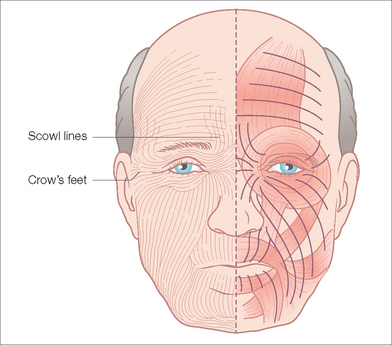Chapter 3 Primary Closure
PRIMARY CLOSURE DESIGN AND CONSIDERATIONS
Basic Definition and Considerations
Primary closure refers to the direct side-to-side apposition of a skin defect or laceration. For a roughly circular defect, placing a suture that brings the central wound edges together will lead to a puckering of skin at either end. These puckered areas are referred to as tissue cones or “dog-ears” (Figure 3.1). Included in any primary closure is the planning for and management of tissue cones.
Designing an Elliptical Excision
Placement
The best aesthetic result is achieved when electively placed incision lines are placed in borders of aesthetic units or in relaxed skin tension lines. Borders of aesthetic units are important in facial surgery and are natural lines separating distinct anatomic units. The upper lip and cheek are separated by the melolabial fold, for example, and a sutured wound in the melolabial fold can often heal nearly invisibly. In addition it is a general rule that lines that visibly cross the borders of aesthetic units are more likely to be noticeable. For this reason one should try to avoid elective incision lines that disrupt borders from one cosmetic unit to another. Figure 3.2 shows examples of aesthetic units on the face and their borders.
Relaxed skin tension lines (RSTLs) refer to the lines created by underlying muscle activity and are often visible in older patients. In younger people these lines are not yet visible without active use of muscles but with age these lines become increasingly apparent at rest. Diagrams of RSTLs exist to help guide the surgeon (Figure 3.3). In many cases RSTLs can be made visible on the patient by having them contract the underlying muscles to exaggerate their appearance. Changing position, for example, pursing the lips, reveals RSTLs around the lip that are radial like the spokes of a wheel. In some areas, multiple muscle groups may be at play and incision lines in more than one direction will predictably do well. Finally individual variation is common.
Design Considerations
It is important to assess relaxed skin tension lines and mark the lines of an ellipse or tissue cone repair while the patient is in the upright position and prior to infiltration of large amounts of anesthesia. Anesthesia can interfere with the assessment of both the relaxed skin tension lines and the direction of maximum skin movement. The classic design of an elliptical excision involves creation of a symmetric fusiform shape that tapers to a 30° angle at each end (Figure 3.4). Angles greater than 30° tend to increase the formation of tissue cones. As a rule, the length of an ellipse is roughly three times its maximal width. This ratio is commonly altered and tailored to the individual wound being closed. For instance, it is often helpful to lengthen the ellipse over convex areas and in thick skin, and it may be shortened in concave areas and in thin skin.











